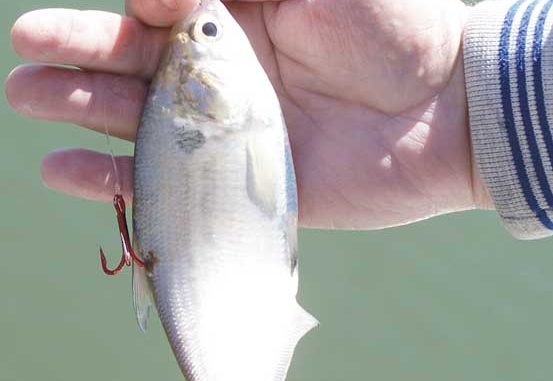
This is the prime month in the search for a Clarks Hill 30-pounder, and a top striper pro shares the prime tactics.
For each species of fish, there’s a threshold that fishermen establish that makes that fish a trophy — one for the wall.
For largemouth bass, that threshold is a 10 pounder. In crappie circles, it’s a slab that tops the scales at three pounds or better.
Multiply those numbers by each other and you’re getting into trophy striped bass territory.
Just as with largemouth bass and crappie, there are particular locations within South Carolina, and particular tactics, that lend themselves more to trophy fishing than for an outing of loading the livewell or “just fishing.”
It’s been said that true trophy striper anglers will diligently fish a stretch of water known to harbor large fish for just one bite. If this type of dedication to the promise of one fish is what you’re after, it’s time to head to Clarks Hill — and carry plenty of live bait.
Clarks Hill — officially J. Strom Thurmond Reservoir — is the third impoundment of the Savannah River that forms the South Carolina-Georgia border.
Over the past eight years, Clarks Hill has traded the South Carolina state-record striped bass back and forth with her Savannah siblings: Lake Russell and Lake Hartwell. Although Hartwell owns the record at present, many veteran fishermen point to Clarks Hill as not only the likely successor, but a strong contender for the next world record.
With a healthy population of large stripers, an abundant forage base and sprawling, fertile waters, Clarks Hill is ripe for the striper fisherman who knows where to look for trophy fish and how to tempt them into eating.
The Carolinas and Georgia boast a large contingent of trophy striper fishermen, as well as fish. Most of these fishermen are active in local and national striped bass clubs, competing regularly to determine who’s best at catching big stripers. Many are members of the Striped Bass Conservation Coalition (SBCC), which developed out of the now-defunct National Striped Bass Association.
Mike Green of Huntersville, N.C., and his “Fishers of Men” team topped the list of NSBA champions with four Gold Cup titles. Green’s team is a force to be reckoned with at any lake in the Carolinas and Georgia, but he is especially resourceful when it comes to Clarks Hill.
Hutch Holseberg, the president of Key West Boats (based in Ridgeville, S.C.), is the primary sponsor of Green’s team. He is quick to tout Green as an accomplished striper fisherman.
“Mike is just an all-around good fisherman,” Holseberg said. “He fishes hard; he knows what he’s doing; and he is always consistent — especially at Clarks Hill.”
Green was willing to provide some of the secrets to his success at catching trophy striped bass at Clarks Hill in April.
Locating fish
Striped bass at Clarks Hill in April are in transition from pre-spawn to spawning patterns. Much is dependent upon prevailing weather conditions and ultimately, water temperatures.
“If you can get on the water after several days of warm weather, you’ll catch big stripers up in real shallow water,” Green said. “They’re keying in on baitfish, and if you can run a big bait in there on them — watch out.”
The best prespawn fishing indicators will be gulls, loons and terns — which will give away the location of baitfish at a distance. Otherwise, if you mark bait on your depthfinder, you can assume that stripers will be nearby.
With luck, clouds of bait on the graph will be mixed in with criss-crossing arches, indicating stripers that are up and feeding.
“I rarely if ever catch the pigs running bait with the smaller fish,” Green said. “The bigger fish are kind of lazy. They follow behind the schoolies and let them do all the work chasing the bait down and injuring a few baitfish. Then, the trophy-sized fish ease in there and mop up.”
On Clarks Hill, larger fish — typically females — will be moving into the upper sections of the lake, where current moving from the tailrace at Lake Russell attracts fish intent on spawning.
“Look for small cuts in the main river run or in the secondary cuts near the mouths of feeder creeks up the lake,” said Green, who also likes to fish feeder creeks in the early spring. “A cut that has water entering near the back from a spring or branch creek is a real bonus.”
The downside to spring’s glamour is its unstable weather patterns. One day may be sunny and warm, then a cold front will arrive, bringing high winds and rain, and after the rain will come a drop in temperature that makes it feel like winter again. Then, a warming trend that’s likely as not accompanied by yet more wind is common.
This weather pattern is typical of prespawn. The best way to deal with spring weather is to locate and identify staging areas where stripers are likely to hold, waiting for that warming trend that will signal the time to spawn.
Prespawn staging begins when temperatures range between 60 and 65. Eating is still the primary focus for these fish, and rising water temperatures mean increased metabolism. Positioning themselves for the spring spawn, however, is next on the list, and fish begin moving upstream to find the most spawn-conducive locations.
According to Scott Lamprecht, a fisheries biologist with the South Carolina Department of Natural Resources, paying attention to the water temperature is a key to figuring out what striped bass are doing.
“At 65 degrees, stripers are most likely to be located in upstream locations,” Lamprecht said. “The spawn is triggered around 68 degrees. Rock bars, sandy flats, and areas with finer bottom aggregate are key locations to find spawning fish.”
While the majority of reservoirs in the United States have not been documented as sustaining striped bass reproduction, almost all striped bass go through the motions to some extent, and Clarks Hill fish are no exception.
It also bears mentioning that members of the shad and herring family favor similar locations and water conditions for their spawn.
“Temperamental striped bass and large baits don’t play together well,” Green said, laughing.
Baits
For Green, only one bait is necessary or desired for catching trophy stripers — a whole, live gizzard shad. “This time of year, all I use is a whole, live gizzard shad,” he said. “If you think the bait is too big, you’ve got the right size,”
Gizzard shad are members of the dorosoma (shad) family. They have a silvery-blue back with iridescent, silvery sides. There is a distinct notch in the upper jaw that extends slightly beyond the lower jaw — under a rounded snout. They have a thick, flat body with circular scales. The average, adult gizzard shad is between nine and 14 inches.
Gizzard shad are a schooling fish, with young fish preferring quiet surface areas. Once they reach adulthood, they orient themselves more to the bottom. Then generally spawn at night in shallow water.
Green prefers to catch his bait either at night or in the pre-dawn darkness before a day’s fishing. He will use the depthfinder on his 22-foot Key West center console to mark bait in the backs of shallow coves, where he can catch them in a cast net.
“Lively bait is a must,” Green said. “For a full day’s fishing, I want to have at least 70 fillet-able sized gizzards in the bait tanks.”
He changes his baits frequently and discards any bait that isn’t actively swimming when he checks his lines. Using big gizzard shad insures that any true bite that bends the rod will be a good fish of at least 10 to 15 pounds.
“Small fish may slap that big gizzard around some, but a big fish will inhale the bait, and.the rod will be dug three guides deep down in the water,” he said.
Tactics
Green’s favorite tactic is known by a variety of names: free-lining, live-lining, pulling baits or planer-boarding. This tactic presents a live bait in the most-natural setting possible. He ties a hook to the end of his main line, then lets the bait do it’s thing — swim and get eaten.
He fishes eight to 10 lines at a time. In order to keep them separated, he attaches a planerboard to the line after casting the bait out behind his boat. The planer acts as a wedge and cuts angles against the line as the boat trolls forward, pulling the bait away and out to the side of the boat.
A key to hooking striped bass that attack large baits is to employ a stinger hook — a treble hook attached to a length of stout monofilament. The other end is tied to the bend of the primary hook. The primary hook, a 2/0 standard “J” hook, is tied directly to the main line and goes through the bait’s nose.
“Using a stinger on a big bait is critical to hooking a trophy fish,” Green said.
Rather than extend the tag end of the main line to the stinger, Green ties the stinger line to the bend so that a hook-set aligns the points of both hooks rather than lever the stinger line against the primary hook.
“Having a slight bow in the line is OK; just make sure you get one of the trebles in the meat behind the dorsal fin of the bait or that stinger will come loose and hang up on something,” Green said.
Once Green has his lines out, he’ll use his trolling motor to bump along a desired stretch of water, using just enough momentum from a combined troll/drift to keep the lines apart. With no weight and ample line to roam, the 10- to 12-inch gizzard shad are free to swim at a depth and action of their choosing. Green said that a large bait requires a large planer board. He builds his own planer boards, in a style that allows him to attach the board to the line with just the clip and no retaining snap swivel. After a trolling run down a stretch of water, he will return to collect the various boards that have broken free from bites or hang-ups.
Green’s choice of tackle is a 7-foot, heavy action Eagle Claw Ocean rod or a Shimano TLD. The rods are outfitted with Penn 310i or 320i baitcast reel spooled with 30-pound monofilament. The bigger reels hold ample line to allow Green to either get a big fish turned or give him time to get on the trolling motor to run the big fish down.
Boats
Green credits much of his success with having all his equipment organized and easily at hand. Like many striper fishermen, he chose and rigged his boat based on his personal fishing preferences. First is ample built-in bait tank space. His boat has two built-in tanks, and he’s added a third, a 40-gallon tank located forward of the console.
Another consideration is deck space. Center consoles allow fishermen to store gear in a central location and still have room to walk around the boat — a plus as trophy stripers have a tendency to go where they want to go until they get played out.
The final key is diligence. Collecting the right bait, being in the right place, and having the tools necessary to get the job done are no guarantee that you’ll get a trophy on every trip. But sooner or later, all the factors will line up and you’ll get your shot. Then it’s just a matter of finding some open wall space in the den.

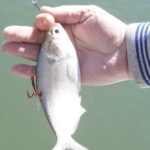
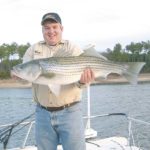
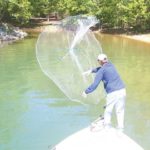
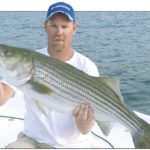

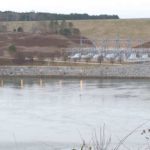
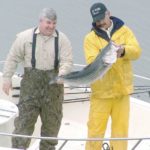



Be the first to comment